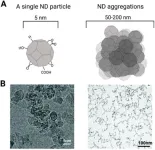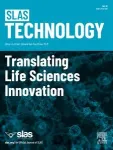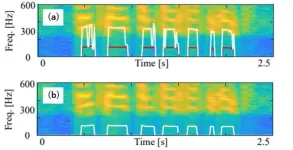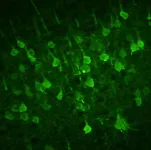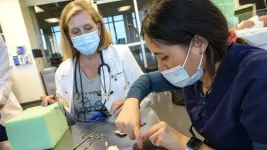(Press-News.org) Oak Brook, IL – The August 2023 issue of SLAS Technology, the open access journal emphasizing scientific and technical advances across the life sciences, is now available. Volume 28, Issue 4, contains a review from the literature and eight full-length articles covering nanodiamonds, automated buffer exchange, epidermal growth factor (EGF) and other laboratory automation-related research.
From the Literature
Life sciences discovery and technology highlights
The authors examine several areas of research within the literature to highlight significant developments in microfluidics, advances in gene editing and high-throughput mass spectrometry in drug discovery.
Full-length articles
Biomedical applications of nanodiamonds: From drug-delivery to diagnostics
This review article provides an overview of the unique properties of nanodiamonds and the potential contributions the carbon nanoparticle can make across preclinical and clinical stages of biomedical research.
In vitro delivery of mTOR inhibitors by kidney-targeted micelles for autosomal dominant polycystic kidney disease
The study explores a potential treatment strategy for autosomal dominant polycystic kidney disease by encapsulating mTOR inhibitors in kidney-targeting nanoparticles, effectively enhancing drug efficacy and minimizing off-target effects in cell cultures.
Mera: A scalable-high throughput automated micro-physiological system
The authors present Mera, a system with multiple fluidic modes for culturing and assaying microtissues, to address the dire need for scalable microphysiological systems.
Incorporation of automated buffer exchange empowers high-throughput protein and plasmid purification for downstream uses
The authors demonstrate two separate automated purifications to showcase the potential of automated liquid handlers for efficient purification of biologics using pipet-based dispersive solid-phase extraction, followed by buffer exchange, resulting in rapid and high-quality biologics production without manual intervention.
Quantitative assessment of automated purification and concentration of E. coli bacteria
The study introduces the automated system “aDARE,” that effectively purifies and concentrates target bacteria from environmental interferents using size-based filtration membranes, demonstrating its feasibility and efficiency for various applications.
Automated sample preparation of protein solid dosage forms: Novel application for the tablet processing workstation
Presented in this article is a first-of-its-kind automated method called the Tablet Processing Workstation to prepare large molecule tablet samples for analysis, significantly reducing labor time compared to manual sample preparation while maintaining analytical accuracy.
SAGAS: Simulated annealing and greedy algorithm scheduler for laboratory automation
The authors propose a solution for improving the scheduling for laboratory automation in biology problems: SAGAS (Simulated Annealing and Greedy Algorithm Scheduler), a fast and effective scheduling method combining simulated annealing and the greedy algorithm, to optimize the scheduling of life science experiments in laboratory automation.
Plant molecular farming-derived epidermal growth factor revolutionizes hydrogels for improving glandular epithelial organoid biofabrication
This study used Nicotiana benthamiana to produce a plant based epidermal growth factor (P-EGF) as a signaling cue to increase organoid formation efficiency. By encapsulating the P-EGF in a hyaluronic acid and alginate hydrogel as a delivery system, researchers significantly improved proliferation of glandular epithelial cells and the cellular viability and growth of the organoids when compared to P-EGF alone.
Access to the August issue of SLAS Technology is available at https://slas-technology.org/issue/S2472-6303(23)X0005-3
*****
SLAS Technology reveals how scientists adapt technological advancements for life sciences exploration and experimentation in biomedical research and development. The journal emphasizes scientific and technical advances that enable and improve:
Life sciences research and development
Drug delivery
Diagnostics
Biomedical and molecular imaging
Personalized and precision medicine
SLAS (Society for Laboratory Automation and Screening) is an international professional society of academic, industry and government life sciences researchers and the developers and providers of laboratory automation technology. The SLAS mission is to bring together researchers in academia, industry and government to advance life sciences discovery and technology via education, knowledge exchange and global community building.
SLAS Technology: Translating Life Sciences Innovation, 2022 Impact Factor 2.7. Editor-in-Chief Edward Kai-Hua Chow, Ph.D., National University of Singapore (Singapore).
###
END
What if we could identify the earliest warning signs of cardiovascular disease from a simple saliva sample? Scientists think they have found a way to do so. Gum inflammation leads to periodontitis, which is linked with cardiovascular disease. The team used a simple oral rinse to see if levels of white blood cells — an indicator of gum inflammation — in the saliva of healthy adults could be linked to warning signs for cardiovascular disease. They found that high levels correlated with compromised flow-mediated dilation, an early indicator of poor arterial health.
“Even in young healthy adults, low levels of oral inflammatory load may have an impact on cardiovascular ...
Lead exposure has long been a known health risk, especially for young children. Research has found that even at low levels, chronic exposure to lead can cause damage to the brain and other organs and cause problems with cognitive and motor skills. In response, public health officials have determined that there is no safe exposure level and have made great efforts to eliminate lead-based paint and lead pipes in homes and phase out the use of leaded gasoline.
But another possible source of lead exposure in children has been largely overlooked: secondhand ...
Researchers at Texas A&M University will spearhead a groundbreaking project to revolutionize medication administration for pediatric patients, thanks to an approximately $3 million grant from the National Institutes of Health (NIH).
This pioneering initiative explores using additive manufacturing, or 3D printing, to create customized tablets tailored to the unique needs of young children. The project is an interdisciplinary collaboration of experts from the College of Engineering, the College of Pharmacy and the School of Veterinary Medicine and Biomedical Sciences.
Traditional manufacturing methods yield mass-produced medicinal tablets ...
Overview
Assistant Professor Yuya Hosoda of the Center for IT-Based Education (CITE), Toyohashi University of Technology developed a method for estimating the pitch of vocal cord vibrations of humans from call audio. In this method, the pitch is estimated by integrating the feature quantities extracted from the amplitude and phase spectra of speech on the complex plane. Through experiments, we have demonstrated that the proposed method is not only efficient for call audios whose frequency band is restricted by communication standards, but also works robustly in an environment with background ...
Niigata, Japan – our movements are controlled by multiple neural pathways that connect the brain and spinal cord. In particular, neurons in the cerebral cortex send commands to the motor neurons in the spinal cord and then to the muscles, thus eliciting the required movement. However, this flow of neural information is compromised in amyotrophic lateral sclerosis (ALS)—a widespread progressive neurodegenerative disease in which the muscles gradually atrophy, making movement and breathing difficult. Moreover, a protein called TDP-43 has been found to abnormally ...
A striking image of the invasive orange pore fungus (Favolaschia calocera), which highlights the potential threats the species may pose to Australian ecosystems, has won the third BMC Ecology and Evolution image competition. The competition showcases the wonder of the natural world — both past and present — and celebrates those working to understand it. The winning images are open access and freely available for use under a Creative Commons Attribution 4.0 (CCBY) license.
The overall winning image depicts bright ...
The end of the last Ice Age also marked the end for more than three dozen genera of large mammals in North America, from mammoths and mastodons to bison and saber-toothed cats. Details concerning the precise timing and circumstances, however, have remained murky ever since.
A team of scientists that included Texas A&M University archaeologist Dr. Michael Waters recently focused on the well-known Rancho La Brea Tar Pits in southern California in their quest to provide answers to these questions, resulting in the most exact and detailed timeline for the extinctions that happened during the latter part of the Pleistocene ...
In trials, the antipsychotic drug brexpiprazole (Rexulti) failed to provide a clinically meaningful benefit and increased the risk of death. Yet the US Food and Drug Administration (FDA) has fast tracked its approval, making Rexulti the first antipsychotic for treating agitation in elderly patients with dementia.
At a cost of around $1,400 a month Rexulti’s makers, Otsuka and Lundbeck, are forecasting an additional $1 billion in annual sales, but there are serious questions about the harm-benefit balance of this drug, writes investigative journalist Robert Whitaker in The BMJ today.
The decision may also reverse ...
The University of Arizona College of Nursing was one of 50 institutions nationwide to receive a Health Resources and Services Administration grant to increase the number and diversity of Doctor of Nursing Practice students in clinical rotations at Federally Qualified Health Center partners in southern Arizona.
The project will use the $2.6 million in funding from the HRSA’s Advanced Nursing Education Workforce Program to deploy immersive managed practice adaptable clinical training, or IMPACT, starting in the spring semester of 2024.
The grant will support students pursuing doctorates in the specialty areas ...
Spectacles that are marketed to filter out blue light probably make no difference to eye strain caused by computer use or to sleep quality, according to a review of 17 randomised controlled trials of the best available evidence so far.
Nor did the review find any evidence that blue-light filtering lenses protect against damage to the retina, the light-sensitive tissue at the back of the eye, as included studies did not evaluate this outcome. Blue-light filtering lenses, also known as blue-light blocking spectacles, have been increasingly prescribed or recommended, often by optometrists, ...
